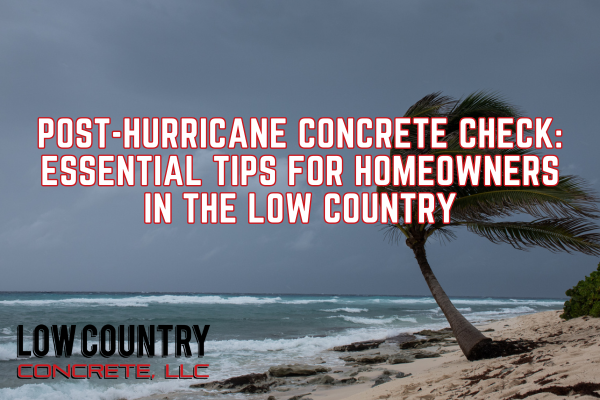The 2024 hurricane season has been particularly impactful for the Carolinas and Georgia, leaving many homeowners with the daunting task of assessing potential damage to their properties. Among the most critical areas to inspect is your concrete, which can sustain significant wear and tear during severe weather events. Low Country Concrete is here to guide homeowners on how to check their concrete for any damage or concerns in the aftermath of the storm season.
Why Inspect Your Concrete?
Hurricanes and tropical storms can wreak havoc on concrete surfaces, including driveways, patios, walkways, and foundations. High winds, heavy rains, and flooding can cause several issues:
- Cracking: Sudden temperature changes and the force of strong winds can lead to cracks in the concrete.
- Settlement: Heavy rains can cause soil erosion, leading to settling and uneven surfaces.
- Surface Damage: Debris carried by wind and water can chip or scuff the concrete surface.
Regular inspections after severe weather can help you catch these problems early, saving you from costly repairs later on.
Step-by-Step Concrete Inspection Guide
1. Visual Inspection
Start with a thorough visual inspection of all concrete surfaces around your property.
- Look for Cracks: Check for visible cracks, especially those that seem to widen or deepen. Pay special attention to areas where water may have pooled.
- Examine the Surface: Look for any chipping, spalling (flaking), or pitting on your concrete. These issues can worsen over time if not addressed.
- Check for Discoloration: Stains or discoloration can indicate water damage or mold growth, which could compromise the integrity of the concrete.
2. Assess Drainage and Grading
Effective drainage is crucial in preventing water accumulation, which can lead to more significant issues.
- Inspect Downspouts and Gutters: Ensure that gutters are clear and directing water away from concrete surfaces. Downspouts should extend far enough to prevent water from pooling near the foundation.
- Check Grading: The ground around your home should slope away from the foundation. If the grading has shifted due to erosion, you may need to re-grade the area.
3. Look for Signs of Settlement
Settlement can lead to uneven surfaces, which may pose safety hazards.
- Uneven Surfaces: Walk around and observe if any concrete slabs are settling or shifting. Look for gaps between slabs or noticeable tilting.
- Door and Window Frames: Check for any misalignments in door and window frames, which could indicate that the foundation is settling.
4. Inspect for Moisture Damage
Hurricanes often bring heavy rainfall, which can saturate the ground and affect concrete structures.
- Check for Water Accumulation: Look for areas where water may have pooled or collected against your concrete, particularly near the foundation.
- Mold and Mildew: Inspect for any signs of mold or mildew, which can thrive in damp conditions. This is particularly important for enclosed areas like basements or garages.
5. Look for Erosion
Severe storms can lead to erosion around concrete surfaces, impacting their stability.
- Examine Landscaping: Check the landscaping around your concrete. If soil has eroded away, it can affect the support of your concrete structures.
- Repair Erosion: If you find erosion, consider adding soil and compacting it to restore support. Plants or landscaping fabric can help prevent future erosion.
What to Do If You Find Damage
If your inspection reveals signs of damage, taking prompt action is essential.
1. Small Cracks and Surface Damage
- Repair Products: Use concrete patching compounds for small cracks. These products are readily available at hardware stores and can be easily applied.
- Sealants: After repairs, consider applying a concrete sealant to protect against moisture infiltration and future damage.
2. Larger Cracks or Structural Issues
- Consult a Professional: For significant cracks, settling, or any structural concerns, it’s best to consult the team at Low Country Concrete. We’re here to help you assess the damage and recommend appropriate repairs.
3. Erosion Issues
- Regrade and Reinforce: If erosion has affected the foundation or surrounding area, you may need to regrade the soil and add landscaping features to prevent further erosion.
Preventative Measures for the Future
Once you’ve assessed and repaired any damage, consider implementing preventative measures to protect your concrete during future storm seasons.
- Regular Inspections: Schedule regular inspections of your concrete surfaces, particularly after severe weather.
- Proper Drainage Solutions: Invest in proper drainage systems, such as French drains, to direct water away from your concrete.
- Sealing: Regularly seal your concrete surfaces to protect against moisture and debris.
Low Country Concrete: Your Post-Hurricane Partner
The aftermath of the 2024 hurricane season serves as a stark reminder of the importance of concrete maintenance. By taking the time to inspect your concrete surfaces and address any concerns promptly, you can help ensure the longevity and stability of your property. Remember, early detection and repair can save you time, money, and stress down the line. Stay proactive, and your concrete will remain a reliable and beautiful part of your home for years to come.


Recent Comments